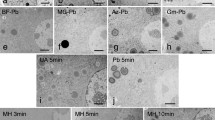Abstract
SOLUTIONS of lead are now widely used by some electron microscopists for the production of a general increase in the electron density of cellular constituents in sections of biological material fixed in osmium tetroxide and afterwards embedded in methacrylate or ‘Araldite’. Grids bearing the sectioned specimens may be floated face downwards for a few minutes on the surface of weakly ionized lead solutions, for example, lead acetate or ‘alkaline’ lead hydroxide1. During this exposure lead ions become attached to the osmium already deposited on the material during fixation, with a consequent improvement of specimen contrast in the electron beam.
Similar content being viewed by others
References
Watson, M. L., J. Biophys. Biochem. Cytol., 4, 727 (1958).
Peachey, L. D., J. Biophys. Biochem. Cytol., 5, 511 (1959).
Author information
Authors and Affiliations
Rights and permissions
About this article
Cite this article
LEVER, J. A Method of staining Sectioned Tissues with Lead for Electron Microscopy. Nature 186, 810–811 (1960). https://doi.org/10.1038/186810a0
Issue Date:
DOI: https://doi.org/10.1038/186810a0
- Springer Nature Limited





